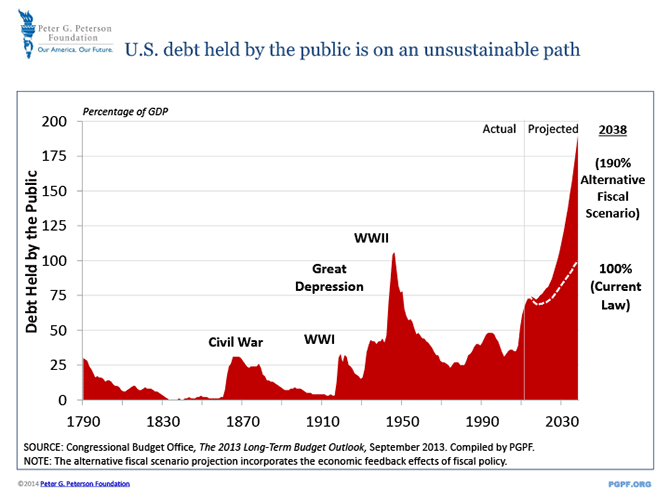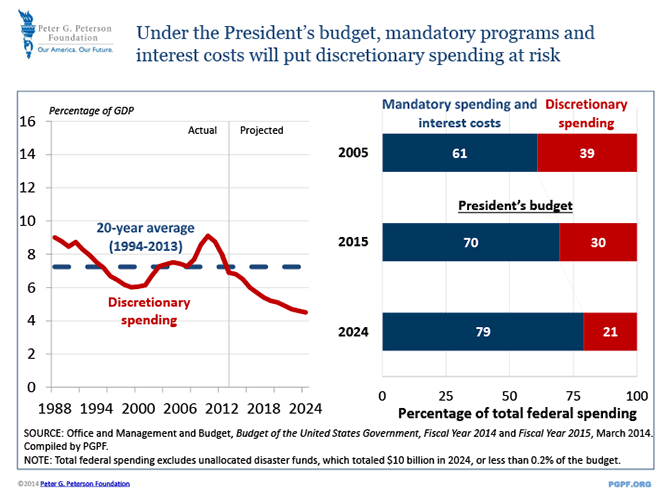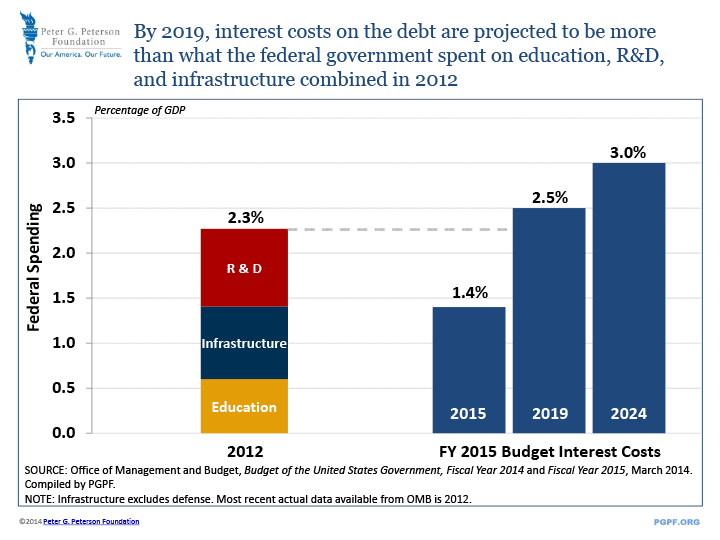You are here
Analysis of the President's Fiscal Year 2015 Budget
INTRODUCTION
The President released his annual budget today, outlining the Administration’s policy proposals, budgetary projections, and economic forecasts for 2015 through 2024.
While today’s deficits are much lower than those during the financial crisis and recession, over the next ten years debt will remain at historically high levels under the policies outlined in the President’s budget. Over the long term, our debt is on a rising and unsustainable path that harms our economy and threatens our future standard of living.
Under the President’s budget, interest costs will rise rapidly, totaling a staggering $5.6 trillion over the next 10 years. In fact, by 2020 interest costs will become the federal government’s third largest spending category for the first time.
The President’s budget does not adequately address the fundamental drivers of longer-term debt: high and rising healthcare and retirement costs, and an inefficient tax system. Regrettably, the Administration dropped the proposal to use chained CPI, a reform that would improve the long-term fiscal outlook by both reducing spending and increasing revenues.
Resolving America’s long-term fiscal problem is critical to ensuring economic opportunity and prosperity for future generations. Because of the absence of policy proposals to address the structural mismatch between federal revenues and spending, long-term debt would continue to grow unsustainably under this budget.
DEBT REMAINS HISTORICALLY HIGH AND WILL CONTINUE TO GROW
Under the President’s budget, debt is projected to be at historically high levels.
- Over the next 10 years, debt held by the public is projected to increase by $6.1 trillion, from $12.9 trillion today to $19.0 trillion in 2024.
- As a share of GDP, debt is projected to be 75 percent in 2015--higher than it has been in any year since 1950, shortly after the end of WWII.
The President's FY2015 Budget
| Actual 2013 |
Current year 2014 |
Budget year 2015 |
Final year 2024 |
Totals 2015-2024 |
|
|---|---|---|---|---|---|
Billions of dollars |
|||||
| Revenues | $2,775 | $3,002 | $3,337 | $5,478 | $43,775 |
| Outlays | 3,455 | 3,651 | 3,901 | 5,912 | 48,705 |
| Deficit | 680 | 649 | 564 | 434 | 4,930 |
| Debt held by the public | 11,983 | 12,903 | 13,592 | 18,986 | N/A |
Percentage of GDP |
|||||
| Revenues | 16.7% | 17.3% | 18.3% | 19.9% | 19.2% |
| Outlays | 20.8 | 21.1 | 21.4 | 21.5 | 21.4 |
| Deficit | 4.1 | 3.7 | 3.1 | 1.6 | 2.2 |
| Debt held by the public | 72.1 | 74.4 | 74.6 | 69.0 | N/A |
SOURCE: Office of Management and Budget, Budget of the United States Government, Fiscal Year 2015, March 2014. Compiled by PGPF.
INTEREST COSTS ON THE DEBT WILL RISE RAPIDLY
The President’s budget projects that interest costs on the debt will climb sharply over the next ten years, as deficits continue and interest rates rise.
- Over the next 10 years, net interest payments on the national debt will cost the nation $5.6 trillion.
- By 2020, interest costs will be the 3rd largest category in the budget, after Social Security and Medicare.

RISING INTEREST COSTS AND MANDATORY PROGRAMS PUT IMPORTANT PROGRAMS AT RISK
One of the concerns about the rising level of federal debt is the financial pressure that it places on important programs in the budget. As interest payments and spending on mandatory programs (such as Social Security, Medicare, Medicaid and other health programs) grow under the President’s budget, other essential federal activities are placed at increased risk of being crowded out.
- Over the next 10 years, spending on interest payments and mandatory programs will climb from 70 percent of total spending in 2015 to 79 percent in 2024. Spending on everything else — including national defense, homeland security, food and drug safety programs, national parks, affordable housing, and the National Institutes of Health — will drop from 30 percent of spending in 2015 to 21 percent in 2024.

Some of the programs that are the most at risk of being crowded out by the rise in mandatory spending are important for long-run economic growth, such as research and development, education, and infrastructure. By 2019, under the President’s budget, interest costs alone will exceed the amount spent for R&D, education and non-defense infrastructure (combined) in 20121. Spending in these areas was already at a level that was 15 percent below the 50-year historical average as a percentage of GDP.

LONG-TERM FISCAL CHALLENGES REMAIN
Relative to the extremely high deficits that occurred during the recent financial crisis, the near-term annual deficits shown in the Administration’s budget are much lower. This is due primarily to the economic recovery, combined with short-term reforms enacted in recent years. However, America still faces fundamental drivers of debt over the long term: high and rising healthcare and retirement costs and an inefficient tax system.
Unfortunately, under the policies outlined in the President’s budget, these fundamental drivers of America’s long-term debt are left unresolved. In fact, the Administration dropped its proposal to use chained CPI, which is a more accurate measure of inflation for indexing Social Security and taxes that was included in last year’s budget and would improve the long-term fiscal outlook by both reducing spending and increasing revenues. Solving our long-term fiscal problems involves more than any single proposal, but chained CPI would have notable long-term structural impact. For example, its impact within Social Security alone would be to eliminate a significant portion (approximately 20%) of the imbalance and strengthen the program’s financial health.
The Congressional Budget Office (CBO) publishes a long-term fiscal outlook every year. In its latest analysis, CBO projected that, within 25 years, federal debt held by the public would rise under current law to 100 percent of GDP, and, under an alternate scenario, would rise to 190% of GDP. The alternative fiscal scenario that makes less optimistic assumptions about future budget policy and incorporates the negative effects of debt on the economy.

In addition to many others, CBO has articulated the risks that high levels of debt pose, stating "the high and rising amount of debt... would have significant negative consequences for both the economy and the federal budget." In a recent report, CBO outlined four of these consequences:
- Increased borrowing by the federal government would eventually reduce private investment in productive capital because the portion of total savings used to buy government securities would not be available to finance private investment. The result would be a smaller stock of capital and lower output and income in the long run..."
- "Federal spending on interest payments would rise, thus requiring more substantial changes in tax and spending policies to achieve any chosen targets for budget deficits and debt."
- "The government would have less flexibility to use tax and spending policies to respond to unexpected challenges, such as economic downturns or wars."
- "The risk of a fiscal crisis--in which investors demanded very high interest rates to finance the government’s borrowing needs--would increase."
As a share of the economy, our national debt is already higher than at any time since 1950, shortly after the end of World War II. This level of debt leaves our nation poorly prepared to enter an era in which demographic changes pose enormous budgetary challenges for the federal government. The Peter G. Peterson Foundation’s Fiscal Confidence Index recently found that a significant majority of voters — 83 percent — agree that policymakers should spend more time addressing the nation’s debt.
Stabilizing the debt over the long term is a key part of any sound fiscal policy and viable economic strategy for America. Unfortunately, this budget represents a missed opportunity to address these challenges. Until we confront these budgetary realities and close the structural imbalance between spending and revenues, America’s economy is at risk. We need to resolve America’s long-term fiscal challenges in order to protect critically important health and retirement programs, invest in our own future, and ensure economic growth and opportunity for future generations.
1Due to the delay in the Office of Management and Budget’s release of supplemental FY 2015 budget-related information, FY 2012 amounts are the latest actual levels available. (Back to citation)
